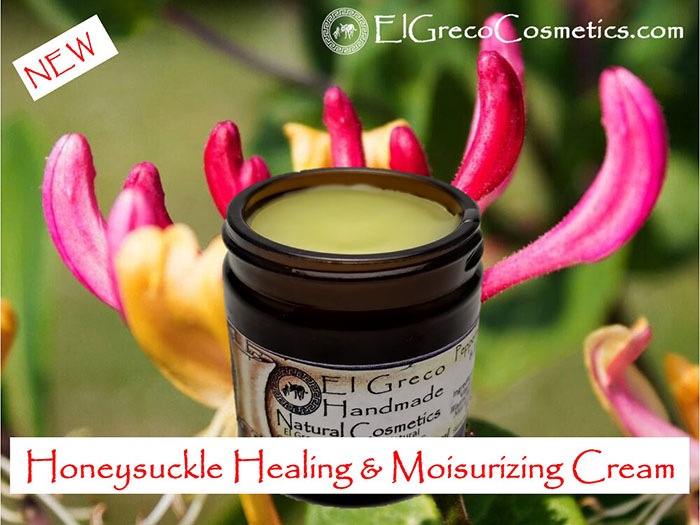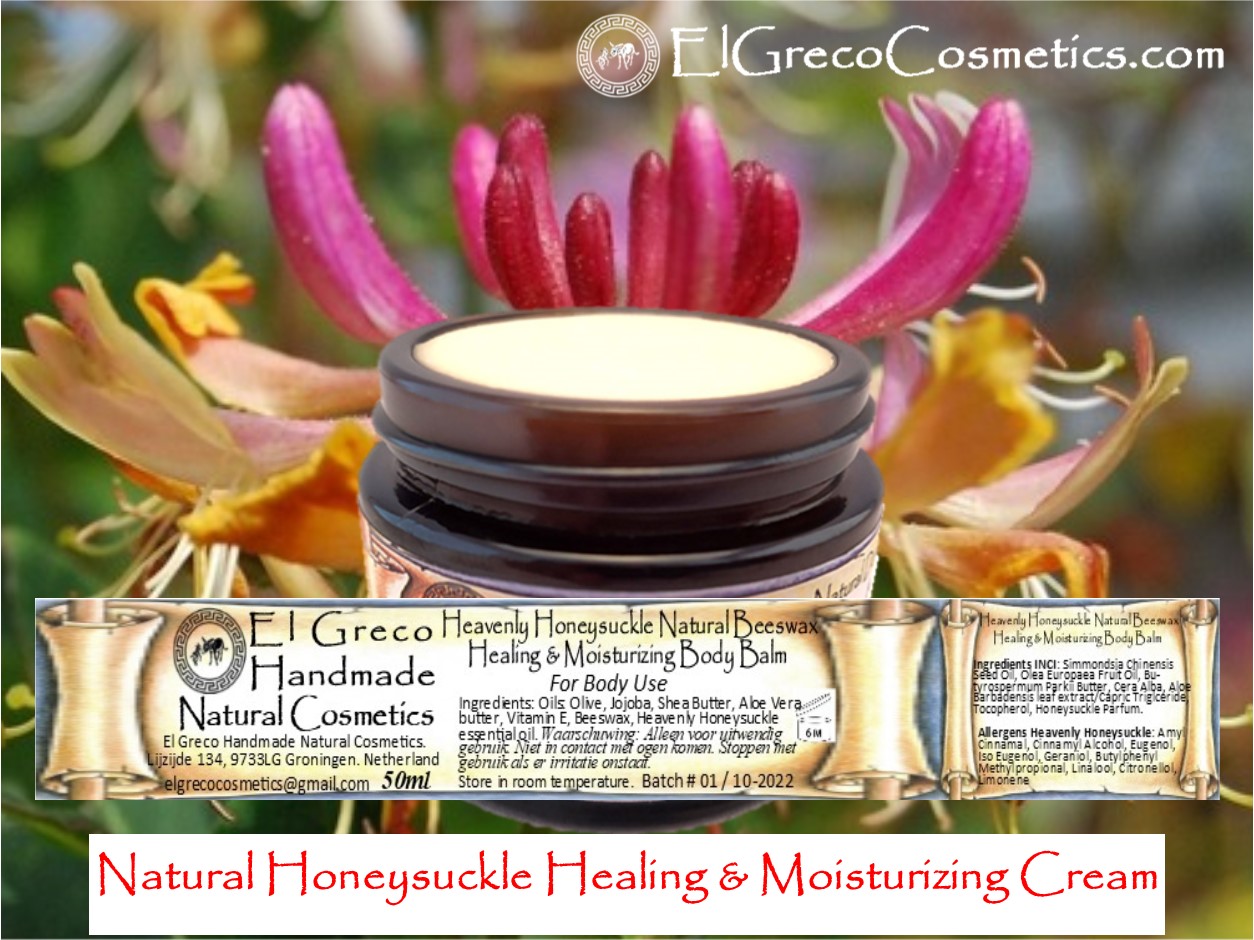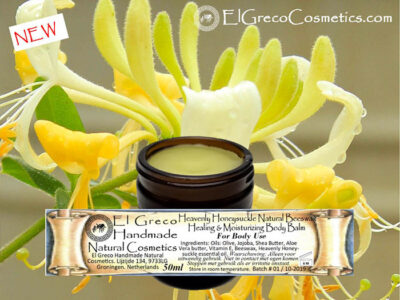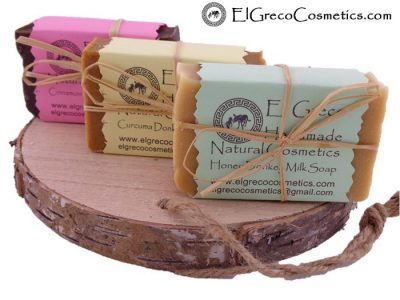Description
3Pack Honeysuckle Natural Healing Cream
Honeysuckle Natural Healing cream
For Hands and Body Use!
Great for all skin types or sensitive skin or dry skin.
Ingredients:
- Jojoba oil, Olive oil, Shea butter, Bees Wax,
- Aloe vera butter
- Vitamin E
- Heavenly Honeysuckle essential oil, or Passionfruit Rose essential oil, or Peppermint essential oil, or Lavender essential oil, or Honey essential oil, or Vanilla essential oil.
- Ingredients INCI: Simmondsia Chinensis Seed Oil, Olea Europaea Fruit Oil, Butyrospermum Parkii Butter, Cera Alba, Aloe Barbadensis leaf extract/Capric Triglceride, Tocopherol, Honeysuckle Parfum.
- Allergens Heavenly Honeysuckle: Amyl Cinnamal, Cinnamyl Alcohol, Eugenol, Iso Eugenol, Geraniol, Butylphenyl Methylpropional, Linalool, Citronellol, Limonene
Our Natural Healing cream is handcrafted. Great for all skin types or sensitive skin dry skin.
In order to make our healing cream we are using as base a very old recepie. This recepie used Hippocrates 3000 years ago to heal the wounds of his patients!
Therefore Honeysuckle Natural healing Cream is made of 100% pure – natural ingredients. Its raw material mixture acts therapeutically on skin problems such as burns or abrasions or eczema and sprains.
Honeysuckle: Properties
This aromatic herb has a soothing effect as it calms inflammations, infections. It also has anti-inflammatory, antimicrobial, antibiotic and antibacterial properties. It protects the human body from bacteria, viruses and infections.
Additionally Honeysuckle is an amazing medicinal plant. It is thought to contribute effectively to the stimulation of the heart. This is why it is used to treat a variety of cardiac disorders. Similarly Honeysuckle has a positive effect on liver, asthma, arthritis and swollen glands.
In conclusion Honeysuckle has many properties
Jojoba oil, Olive oil, Shea butter, Bees Wax in Natural Healing cream.
These oils and butter are carefully blended together to produce a superior handcrafted Natural Healing cream.
In conclusion, each of these oils is chosen for the special characteristics that give to the Natural Healing cream.
Jojoba oil in Natural Healing cream.
What is jojoba oil?
Eventually jojoba plant is a hearty, perennial plant that grows in North America. Not only does it thrive in the harsh, desert climates that could kill most living things, but it also produces a nut with many healing properties.
Although the nut of the jojoba plant can be made into an oil. Jojoba oil is gentle enough to be used as a carrier oil to mix with other essential oils. You can also use it on its own.
Many people use jojoba oil as part of their skincare routine. And there are good reasons for that. There’s plenty of evidence supporting the use of pure jojoba oil as a remedy for acne, dry skin, and countless other skin conditions. In order to increase the skincare routine.
It’s moisturizing
Jojoba oil is a humectant ingredient. This means that it works to seal your skin with a protective barrier to keep it from losing moisture. This may help prevent bacterial infections, acne, and dandruff from forming. Put differently jojoba oil is a moisturizer.
It’s antibacterial
This oil contains antimicrobial and antifungal properties. While lab testsTrusted Source found that jojoba oil doesn’t kill all bacterial or fungal species, it does kill certain bacteria and fungi that can cause salmonella, an E. coli infection, and candida.
It’s an antioxidant
The oil of jojoba contains natural forms of vitamin E. This vitamin works with your skin as an antioxidant. This means that jojoba oil can help your skin fight oxidative stress caused by everyday exposure to pollutants and other toxins.
It’s noncomedogenic
Although jojoba oil is a botanical substance, its makeup is so similar to the oil (sebum) your body naturally produces that your skin can’t tell the difference.
Next makes it less likely to build upon your skin and clog your pores, leading to fewer breakouts and less severe acne.
It’s hypoallergenic
Finally on a molecular level, jojoba oil is a wax. Although it can be absorbed into your skin, its waxy nature allows it to create a soothing seal on the surface.
Unlike other botanical essential oils, jojoba oil is typically nonirritating. An allergic reaction is rare.
It helps control sebum production
It regulates sebum production because it’s so similar to the sebum that your body produces naturally.
When you put jojoba oil on your skin, your skin is soothed and moisturized. This sends a signal to your hair and sweat follicles that your skin doesn’t need additional sebum for hydration.
This keeps skin from looking oily and helps prevent acne caused by clogged pores.
It may help promote collagen synthesis
The antioxidants in jojoba oil may help your body produce collagen. Collagen is a protein that’s in your skin and joints as well as the parts of your body made of cartilage.
Collagen levels decrease as you get older. This is part of the reason your facial structure changes as you age.
It may help speed up wound healing
Is a promising ingredient in stimulating wound healing. Preliminary research shows that jojoba oil encourages your skin cells to bind together after they’ve been separated by a scratch or cut.
This may also be the reason for its ability to treat acne and acne scarring. These wound-healing properties could be connected to jojoba oil’s concentration of natural vitamin E.
It may help soothe eczema or psoriasis and other drying skin conditions
Has anti-inflammatory and healing properties. Topical applications may help relieve dryness, flaking, itching, and related symptoms.
People who have inflammatory skin conditions like psoriasis and eczema may find jojoba oil especially beneficial.
It may help soothe sunburns
Jojoba oil is a popular ingredient in some natural sunscreen products. One study suggests that vitamin E, when combined with other antioxidants, can help protect your skin from sun damage. Jojoba oil contains both.
Although sun damage can dehydrate your skin and cause flaking. Jojoba oil restores vitamin E, adds moisture, and promotes healing to soothe these symptoms of sunburns.
It may help treat acne
At least one clinical trial indicates that jojoba oil can help keep acne at bay. Jojoba oil has soothing anti-inflammatory agents, healing properties, is moisturizing, and is a natural antimicrobial.
Similarly these properties suggest that jojoba oil could help you avoid breakouts as well as promote healing for mild acne.
It may help reduce the appearance of fine lines and wrinkles
Oxidative stress can be linked to the appearance of fine lines and wrinkles. There’s no research that links jojoba to treating wrinkles and fine lines directly, but other plant products with antioxidant properties have been shown to improve the elasticity of the skin.
This means that the antioxidant power of jojoba oil may help slow the signs of aging when used on your skin.
It may help minimize the appearance of scars
Vitamin E has long been recommended by health professionals to help with scarring. Research on whether this works — and, if so, to what extent — is still ongoing.
If you’d like to try vitamin E as a remedy to scarring, jojoba oil may prove to be beneficial in the healing process.
Equally Jojoba oil’s natural wound-healing properties combined with its vitamin E content could minimize the appearance of scars.
Olive oil in Natural Healing cream.
Yet, olive oil, popularly known as liquid gold, is a proponent of the chefs and dieticians because of its numerous health benefits. It is frequently used in salad dressing or cooking. But are you aware that it has several beauty and hair benefits apart from just health benefits?
Benefits of Olive Oil for the skin.
Anti-aging properties – Olive Oil contains a great amount of Vitamin E and also antioxidants which help in protecting the skin. It helps in delaying the signs of aging.
Moisturises skin – Olive oil is effective in curing all skin-related problems. It is a miraculous product for those who have dry skin. Regular use of olive oil can bring shine to your skin.
However Repairs cracked heels –
Eventually Exfoliate your heels and bring them back to life with the help of olive oil.
Nail health –
As olive oil is rich in Vitamin E it helps in bringing the brittle nails back to life.
Shea butter in Natural Healing cream.
Shea butter is fat that has been extracted from shea tree nuts. It’s off-white or ivory colored and has a creamy consistency. Tat is to say that’s easy to spread on your skin. Most shea butter comes from shea trees in West Africa.
High concentrations of fatty acids and vitamins make shea butter an ideal cosmetic ingredient for softening skin. Shea butter also has anti-inflammatory and healing properties. Using shea butter on your body, especially your face, can condition, tone, and soothe your skin.
Benefits of Shea Butter for your face
Shea butter in Natural Healing cream anti-inflammatory and healing properties
This butter has been proven to have extensive anti-inflammatory properties. Redness and swelling on your face may be calmed by applying shea butter products. Shea butter’s fatty acid and vitamin K concentration also help your body to heal faster when your skin barrier has been compromised.
Shea butter in Natural Healing cream Emollient properties
Also Shea butter’s consistency and semisolid characteristics help your skin to absorb it when it melts at room temperature.
The rich tree nut oils in shea butter can soak into your skin. Creating a smooth and soft barrier that seals in moisture.
This moisturizing effect can last several hours, unlike some other moisturizers that wear off after one hour or less.
Anti-aging properties
It has high levels of oleic, linoleic, and stearic acids.
These acids are an effective ingredient to combating oxidative stress. Which is the effect the environmental toxins have on your skin cells. This helps your skin to have a healthy turnover of new cells. And also supports the structure and tightness of your skin.
The vitamin E in shea butter also helps protect your skin from the UV rays of the sun, although you can’t skip sunscreen just because you use shea butter on your face.
Bees Wax in Natural Healing cream.
Beeswax consists of a mixture of plant wax, pollen and a secretion from the gland on the underside of the bee and is perfectly adapted for use in natural skincare products. In other words Bees wax is a 100% natural ingredient.
It is good for reducing dryness as beeswax is a humectant, which means it binds water molecules to the skin.
In conclusion Beeswax is a good source of vitamin A, which improves hydration and the shedding of dead skin cells.
It also has a pleasant, all-natural, and light honey scent.
This is an excellent ingredient for sensitive or dry skin In the same way as it is anti-allergenic and easily tolerated.
Beeswax is extracted from honeycombs.
Bees secrete wax from their glands and use it to make honeycombs. In the same way as protection, for honey storage, and a place for baby bees to live.
Benefits of Beeswax
1) Bees Wax in Natural Healing cream Lock in skin’s hydration
Not only does Beeswax help to keep water out, it also helps keep water in. By acting as a protective, breathable layer on the skin’s surface, beeswax helps to lock in moisture for soft, supple, hydrated skin.
Because of this some high street make-up products can be extremely drying for the skin, especially those in loose powder forms. Choosing organic make-up that contains Beeswax helps to keep skin in its natural balance for a healthy, radiant complexion.
2) Bees Wax in Natural Healing cream Gorgeously creamy texture
Adding Beeswax to powder types of make-up such as foundations, eyeshadows, and blushers. Gives these formulas a wonderfully creamy texture. This means that unlike some mainstream powders. These products won’t cling, crease or accentuate dry patches on the skin. Giving a smooth finish with a dewy glow. As a result Bees wax is a must product for cosmetics.
The creamy texture of make-up products containing Beeswax makes them very easy to apply and to get your desired even coverage. Because of this, this natural ingredient makes our make-up products ideal for those with dry, sensitive skin who need light, non-irritating formulas that also allow the skin to breathe.
3) Bees Wax in Natural Healing cream protect against environmental damage
The natural barrier properties of Beeswax also help to protect the skin from environmental damage, such as traffic pollution and cigarette smoke.
Moreover when these forms of pollution touch the skin, they can spawn damaging free-radicals, which are known to be a factor in causing premature skin aging. Applying make-up products that contain Beeswax forms a protective layer on the skin’s surface, Likewise preventing pollution from touching the skin which helps to stop the formation of skin-aging free radicals.
This preventative layer of Beeswax is particularly good as it doesn’t block the pores and won’t stop the skin from being able to breathe.
Other Benefits of Beeswax.
- Anti-inflammatory
- Enhances elasticity
- Anti-allergenic
- Softens skin
- Great for sensitive skin
- Full of antioxidants
- Anti-bacterial
Beeswax is Used In Moisturizers, Creams, Lotions, Pomades, Salves, Lip Balms, Lipsticks, Deodorants, Perfumes
Aloe Vera Butter in Natural Healing cream.
IT IS SOOTHING TO THE SKIN, USE IN BUTTERS, LOTIONS, AND GELS, USEFUL FOR SUNBURN, EASILY BLENDED WITH ESSENTIAL OILS
Aloe Butter
Aloe extracted with coconut.
In the same way Aloe butter is Rich in Aloe, Pure aloe extracted into butter for use neat on the skin or for blending into skincare products.
Uses
Aloe butter contains all the key properties of Aloe Vera, skin soothing and restoring with rapid rehydration properties to quickly hydrate and moisturize the skin. To summarize you can use aloe butter to calm the skin.
Additionally Aloe vera has natural anti-inflammatory properties. And as a result naturally contains lignin which aids its ability to draw in other ingredients to this skin. This makes Aloe Butter the perfect butter to blend with essential oils intended for the skin. Natural Aloe not only soothes the skin but draws in your added oils to aid their effects.
Benefits of Aloe Butter
- Rich in Vitamins A, C, E, B, Choline, B12, Folic Acid, highly antioxidant and skin rejuvenating.
- Wound Healing & Anti-inflammatory
- Thought to provide penetrating power in Aloe vera skin preparations. That is to say that may act as a carrier for other components
Vitamin E in Natural Healing cream.
Antioxidant
Ultimately Vitamin E is an antioxidant. It helps protect cells from damage. This nutrient occurs naturally in many foods. It is also available as a supplement. Some processed foods contain it too. Vitamin E is fat-soluble. This means the body stores and uses it as needed.
To clarify the term “vitamin E” describes eight different compounds. Alpha-tocopherol is the most active one in humans.
Longer cell life
You’ve probably seen rust on your bike or car. A similar process of oxidation and accelerated aging takes place in your body when cells are exposed to molecules called free radicals. Free radicals weaken and break down healthy cells. Therefore these molecules may also contribute to heart disease and cancer.
Free radicals form as a result of normal body processes. They cause damage that shortens the life of your cells. Vitamin E is a powerful antioxidant that may help reduce free radical damage and slow the aging process of your cells, according to the National Institutes of Health (NIH).
Heavenly Honeysuckle essential oil in Natural Healing cream
Natural Healing cream Cosmetic
Honeysuckle essential oil Natural Healing cream Cosmetic: etoxifying properties which help to restore glowing and fresh skin. On the other hand skin troubles such as blemishes or rashes or acne or cuts and abrasions. You can treat them effectively by using this absolute oil..
In other words Honeysuckle Essential Oil Natural Healing Cream comes from dried honeysuckle petals using solvent extraction.
Honeysuckle, native to the Northern Hemisphere, belongs to the Caprifoliaceae family. It is also called woodbine, Plumeria alba, and Lonicera Caprifolium.
This oil has antibacterial properties and helps treat sore throats. Its antioxidants make it popular in anti-aging cosmetics. That is to say Perfume makers widely use it for its sweet floral scent.
As name “honeysuckle” awakens the senses. Its fragrance signals the arrival of summer. Bringing this plant indoors allows you to enjoy its benefits year-round. In other words honeysuckle is a summer flower.
Few plants evoke memories like honeysuckle. Its trumpet-shaped flowers and sweet scent recall childhood summers. Therefore the red and white blooms attract hummingbirds, adding to its charm. Beyond its lovely fragrance, honeysuckle essential oil offers many proven benefits.
Antibiotic Properties
Honeysuckle essential oil has a long history of being a popular way to treat various infections due to the antibiotic properties this oil possesses.
Treat Wounds
When my kids got cuts, I used antibacterial cream with chemicals for pain relief. This happened often. After researching essential oils, I replaced all my creams. Honeysuckle oil reduces inflammation and protects against infection.
Cool Down
Honeysuckle’s cooling properties were first recorded in Chinese medicine in 659 AD. It treats snake bites by drawing out toxins. Europeans later used it to calm women during childbirth. Some believe it reduces inflammation.
The lavender essential oil in Natural Healing cream.
1. Symptoms of premenstrual tension
Up to 75% of women experience premenstrual tension (PMT). Symptoms include bloating, pain, irritability, anxiety, and low mood. Aromatherapy with lavender oil can help. Add a few drops to a diffuser and inhale for 10 minutes. This can improve mood and reduce confusion for up to 35 minutes. In other words lavender oil is a must for cosmetics.
2. Increased sleep quality
First, Lavender oil is calming or sleep-inducing effects.
Research has now shown that lavender essential oil can significantly improve sleep quality.
By adding a few drops of lavender oil to your pillow every evening before bed you can drift off to dreamland and get a good night’s rest.
3. Reduced anxiety
Second, it improves sleep and reduces anxiety. Inhaling its oil for 15 days lowers anxiety levels.
A study found that lavender fragrance in a dental office calmed patients.
Carry a bottle with you and take a sniff when feeling stressed. Don’t forget it for your next dentist visit!
4. Promotes hair growth
Thirth, Lavender helps maintain healthy skin. And promotes hair growth.
Want longer, fuller hair? Give it a try!
Studies suggest it supports hair growth. When combined with thyme, rosemary, and cedarwood, it can help with hair loss.
Daily scalp massages with these oils improve alopecia areata (spot baldness).
In the same way Lavender promots hair growth.
5. Assists in wound healing
Lavender oil has some wonderful properties. That help with wound healing. When applied to a minor wound, it can help promote healing. By helping the minor wound to contract. And speed up the process of tissue repair.
Additionally you can add 4 drops of lavender oil to 10 gm of vitamin e cream or coconut oil and apply it to the minor wound.
Finally Lavendel oil is a wonder for cosmetics.















Reviews
There are no reviews yet.